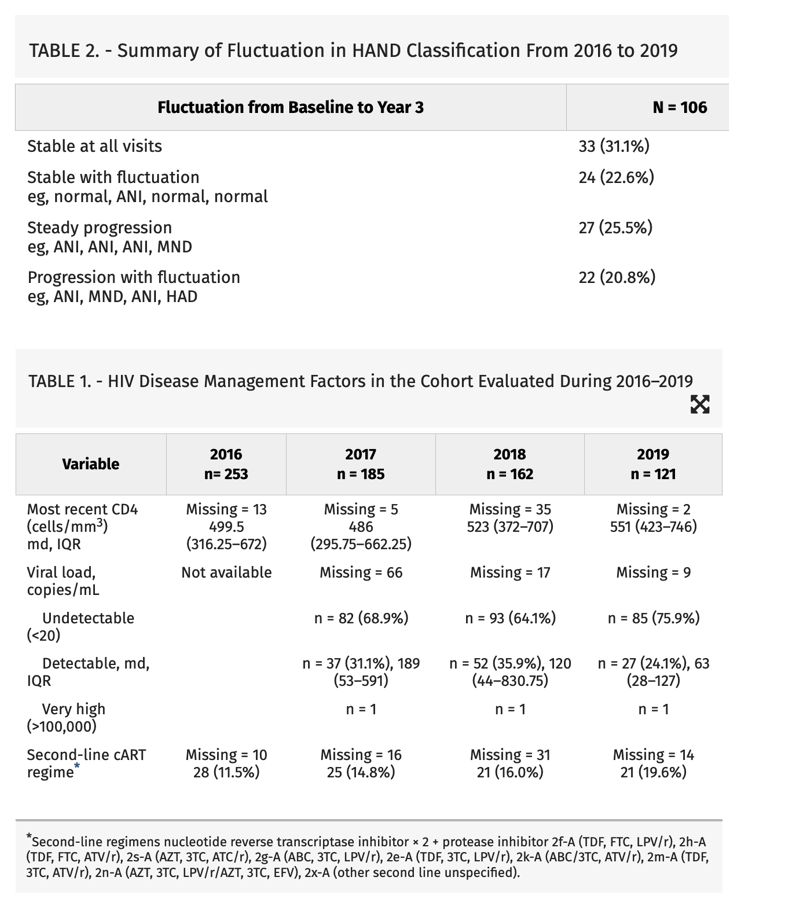| |
HIV-Associated Neurocognitive Disorders:
The First Longitudinal Follow-Up of a
cART-Treated Cohort of Older People in Sub-Saharan Africa
|
| |
| |
Download the PDF
JAIDS June 1 2022
Abstract
Background:
HIV-associated neurocognitive disorders (HAND) are a highly prevalent chronic complication in older people living with HIV (PLWH) in high-income countries. Although sub-Saharan Africa has a newly emergent population of older combination antiretroviral therapy (cART)-treated PLWH, HAND have not been studied longitudinally. We assessed longitudinal prevalence of HAND and have identified possible modifiable factors in a population of PLWH aged 50 years or older, over 3 years of follow-up.
Methods:
Detailed neuropsychological and clinical assessment was completed annually in the period 2016-2019 in a systematic sample of cART-treated PLWH in Kilimanjaro, Tanzania. A consensus panel defined HAND using American Academy of Neurology criteria for asymptomatic neurocognitive impairment, mild neurocognitive disorder, and HIV-associated dementia. HIV disease severity and other factors associated with HAND progression, improvement, and stability were evaluated in individuals fully assessed at baseline and in 2019.
Results:
At baseline, 47% of the cohort (n = 253, 72.3% female individuals) met HAND criteria despite good HIV disease control [Y1 59.5% (n = 185), Y2 61.7% (n = 162), and Y3 57.9% (n = 121)]. Of participants fully assessed at baseline and year 3 (n = 121), HAND remained stable in 54% (n = 57), improved in 15% (n = 16), and declined in 31% (n = 33). Older age and lower education level significantly predicted HAND progression, whereas HIV-specific factors did not. Male sex and shorter cART duration were associated with improvement.
Conclusions:
In this first longitudinal study characterizing clinical course of HAND in older cART-treated PLWH in sub-Saharan Africa, HAND was highly prevalent with variable progression and reversibility. Progression may be more related to cognitive reserve than HIV disease in cART-treated PLWH.
HAND seem to progress despite cART and a degree of reversibility is reported, unlike neurodegenerative dementias.13,14
At baseline, HIV disease seemed well controlled [95.5% on cART, median CD4 499.5 (IQR 316.25-672)], although a high proportion (82.6%) were WHO stage 3 to 4. Self-reported cART adherence was good (77.8% never forgetting medication). Only 28 individuals (11.5%) were receiving second-line treatment (indicative of initial treatment failure). The mean age at HIV diagnosis was 51.2 years, and the median time from diagnosis to cART commencement was 3 months. Correspondingly, the median nadir CD4 count was low (165), indicating that from diagnosis, a high proportion met the superseded WHO treatment guidelines (where cART treatment was delayed until advanced disease).25
HIV disease characteristics of participants seen at each time point are summarized in Table 1. HIV disease control seemed to improve over the study period in those participants followed up, and the median CD4 increased (499.5 in 2016; 551 in 2019). From 2017 (when testing became available), the proportion virally suppressed (HIV viral load ≤20 c/mL) increased and the median HIV viral load decreased.
Clinical Course and Progression of HAND
Of those assessed at baseline and year 3 (n = 121), HAND category remained stable/unchanged in 54% (n = 57), improved in 15% (n = 16), and declined in 31% (n = 33) of individuals. Individuals meeting criteria for non-HAND cognitive impairments at baseline or year 3 (n = 15) were excluded from this analysis. HAND category (normal/ANI/MND/HAD) remained unchanged or declined, termed stable or steady progression, in 60 (56.6%) individuals, but fluctuation and reversibility (improvement) were observed, termed fluctuation, in 46 (43.4%) individuals. The degree of yearly fluctuation, indicating the level of heterogeneity in the cohort, is listed descriptively in Table 2.
We also found older age to be a significant predictor for HAND decline, as in the CHARTER study and in contrast to the MACS. Older age at HIV diagnosis has been associated with worse outcome11 potentially due to longer duration of untreated disease. However, we found no association with progression of HAND and older age at diagnosis. We postulate the age-related increased risk of decline we observed could partly be due to age-related cognitive decline and/or neurodegenerative processes such as Alzheimer disease or vascular cognitive impairment. Because neuroimaging was not available, it is possible that these conditions may have been, instead, reported as HAD, although diagnoses were established by senior clinicians with experience in dementia diagnosis.
Noncompletion of primary education was a predictor of decline. The MACS did not show this association (comparison-eighth grade education),14 and CHARTER study found higher education to be associated with HAND improvement.13 These studies are difficult to compare given the much higher mean education in HIC cohorts.13,14 Lower education may represent lower cognitive reserve, a well-evidenced risk factor of cognitive decline and dementia,29 but in SSA may be confounded by other factors such as childhood disadvantage and lower socioeconomic status. It is therefore difficult to comment on whether education is in fact protective in this setting.
Fewer months on cART at baseline predicted improvement. This finding could be explained by the neurotoxic side effects of cART, but notably, we found no association with baseline use of efavirenz, well recognized to exhibit neuropsychiatric side effects.30 It seems more likely that individuals recently diagnosed with HIV may have greater potential for improvement on starting medication, as noted in other studies.12 Again, these are tentative conclusions based on small numbers.
Of interest, we found no association with nadir CD4 (often termed legacy effect)26 and HAND decline despite legacy effect being associated with HAND cross-sectional prevalence in a recent meta-analysis of global data of PLWH of all ages.10 Generally, we found little association between HIV disease severity factors and decline, a finding also seen in HIC settings, for example, CHARTER study and MACS, although one study found cART CPE score to predict decline. This suggests that other factors, such as comorbidities and socioenvironmental factors, may be relevant.

|
|
| |
| |
|
|
|